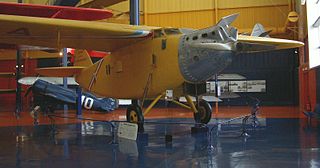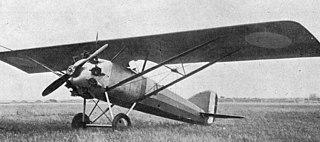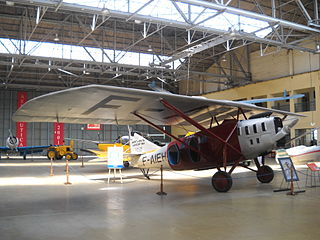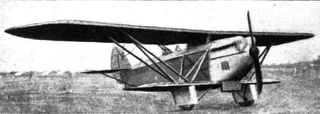
The Aero Letňany A.10 was a biplane airliner produced in Czechoslovakia shortly after World War I. It was the first commercial aircraft to be built in Czechoslovakia and was known as the Ae-10 Limousine. It was designed by Husnik and Vlasak and was intended to meet the growing need for aerial communication to and from the country. Behind the single nose-mounted engine was a cabin with seats for three and two tables, upholstered on the underside, and able to be inverted to provide another two seats if required. A double skinned firewall between the engine and cabin, together with double skinned surfaces to the walls, floor and roof and Triplex windows gave a (relatively) quiet ride. A rear window gave communication with the pilot, whose open cockpit was above and behind the cabin. The cockpit also accommodated the navigator who had a seat directly behind the pilot.
The IAR 14 is a Romanian low-wing monoplane fighter-trainer aircraft designed before World War II.

The WZ.X was the Polish reconnaissance aircraft designed in the mid-1920s and manufactured in the Centralne Warsztaty Lotnicze (CWL) - Central Aviation Workshops in Warsaw. It was the first combat aircraft of own design built in Poland, in a small series.

The Farman F.60 Goliath was a French airliner and bomber produced by the Farman Aviation Works from 1919. It was instrumental in the creation of early airlines and commercial routes in Europe after World War I.

The Avia BH-11 was a two-seat sport aircraft built in Czechoslovakia in 1923, a further development of the Avia BH-9. The main changes in this version involved a redesign of the forward fuselage. 15 examples were ordered by the Czechoslovakian Army as trainers and general liaison aircraft, and operated under the military designation B.11.

The Avia BH-26 was a two-seat armed reconnaissance aircraft built in Czechoslovakia in 1927. It was a single-bay unstaggered biplane with equal-span wings and a fixed tailskid undercarriage. Both upper and lower wings featured long-span ailerons, which were dynamically balanced by a small auxiliary airfoil mounted to the upper surface of the lower ailerons. Its design was typical of this type of aircraft built during World War I and the years following; pilot and observer sat in tandem open cockpits with the observer armed with a machine gun on a ring mount. As with many other Avia designs, the BH-26 originally had no fixed fin, only a rudder, but this was changed in service.

The Avia BH-29 was a trainer aircraft built in Czechoslovakia in 1927, in the hope of marketing it to both the Czechoslovakian Army, and to Czechoslovakian Airlines as a primary trainer. It was an conventional design, an unequal-span biplane of wooden construction and with tailskid undercarriage. The pilot and instructor sat in tandem open cockpits. A more powerful version was built, powered by a 120 hp (89 kW) Walter NZ-120 radial engine.
The Letov Š-16 was a Czechoslovak single-engined, two-seat biplane bomber. It was designed by Alois Šmolík at Letov Kbely. The Š-16 first flew in 1926.

The Bernard 190 or Bernard-Hubert 190 was a French airliner of 1928. It was a high-wing cantilever monoplane of conventional configuration, based on the Bernard 18. Compared with its predecessor, it kept the same basic design but featured redesigned tail surfaces, an enlarged cabin, and offered its flight crew a completely enclosed cockpit. Also like its predecessor, the basic airliner model provided the basis for a long-range aircraft to be used in record attempts, the 191GR.

The Blériot-SPAD S.61 was a French fighter aircraft developed in 1923. Designed by André Herbemont, the S.61 was a conventional biplane, abandoning the swept upper wing used by Herbemont in several previous designs. The prototype S.61 was evaluated by the French Air Force alongside the S.51 as a potential new fighter, but like its stablemate, was rejected. The Polish Air Force was impressed enough to order 250, as well as purchase licences for local production. The Romanian Air Force also ordered 100 aircraft. About 30 were built in Poland, by the CWL.

The Bréguet 280T was a French biplane airliner of the late 1920s, created by the manufacturer as a means of finding a civil market for their 19 warplane, as they had once tried before with the 26T.

The Caproni Ca.101 was a three-engine Italian airliner which later saw military use as a transport and bomber. It was designed in 1927 and first flown in 1928.

The Farman F.120 and its derivatives were a family of multi-engine airliners and bombers of the 1920s built by the Farman Aviation Works in France.

The Caproni Ca.97 was a civil utility aircraft produced in Italy in the late 1920s and early 1930s. As originally designed, it was a high-wing braced trimotor monoplane of conventional configuration with one engine mounted on the nose and the other two carried on strut-mounted nacelles at the fuselage sides. Examples were also produced with only the nose engine or only the two nacelle-mounted engines.

The Focke-Wulf A 20 Habicht was an airliner developed in Germany in the late 1920s. It was a high-wing cantilever monoplane with fixed tailskid undercarriage. The fuselage was deep and seated four passengers in a fully enclosed cabin. The type was not bought by the airlines and only a few examples were built.

The PWS-1 was a Polish two-seat fighter and reconnaissance aircraft constructed by Podlaska Wytwórnia Samolotów (PWS) in 1927. It remained a prototype for its entire lifespan.

The Gourdou-Leseurre GL.30 was a racing aircraft built in France in 1920 which formed the basis for a highly successful family of fighter aircraft based on the same design.

The Latécoère 25 was a French airliner built in 1925 for use on Latécoère's own airline and its subsidiaries. Essentially a refined version of the Latécoère 17 with an enlarged wingspan, it supplanted that type in production and then in service.
The SABCA S.11 or SABCA S.XI was a prototype Belgian airliner of the 1930s. It was a three-engined high-winged monoplane intended for service in the Belgian Congo, but only a single example was built.

The Descamps 17 A.2 was a two-seat reconnaissance fighter built under a French government programme of 1923. Two versions, with different engines, were tested and six examples were built under licence by Caudron as the Caudron C.17 A.2.



















